#Hagia Sophia details
Explore tagged Tumblr posts
Text
@torc87 in the replies to this post mentioned loving renowned Russian-Armenian 19th century painter Ivan Aivazovsky, inviting us to look him up.
I just did, and now I'm marveling at his seascapes and, especially, Aivazovsky's use of color. He graduated from the Imperial Academy of the Arts in St Petersburg with high honors, and also studied in Italy — where I suspect he may have adapted the bold color glazes of Titian — France, and the Netherlands.   In fact, he was a world traveler, as his misty paintings of Niagara and the Great Pyramid attest.
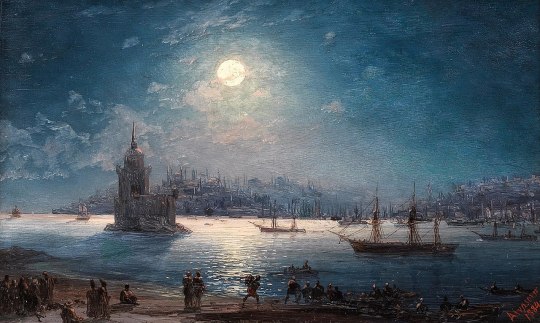
A View of the Bosphorus with the Hagia Sophia and the Maiden's tower in the Moonlight.
(more striking pictures below!)

Ship at Sea (notice it's mostly two complementary colors, and he lets the background show through some areas while treating others with a draftsman's attention to detail... this painting is about 1860. Aivazovsky was working in Paris in 1856-57, about the time the Impressionists were scandalizing the Salon.
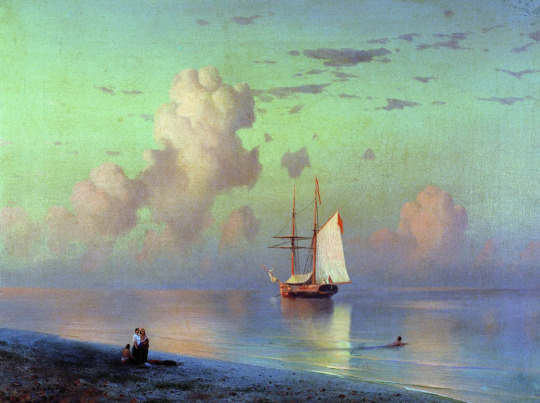
Sunset 1866

The Ninth Wave (survivors of a shipwreck about to have a very bad time)
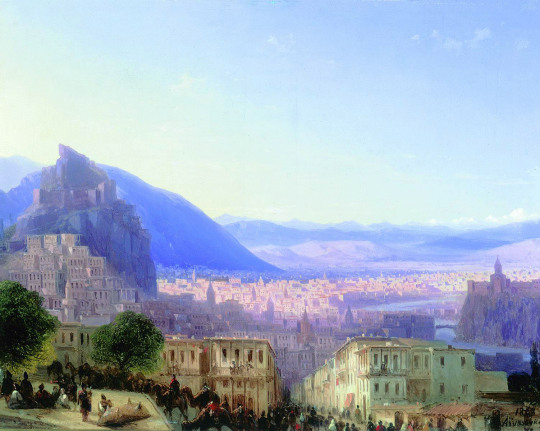
Tiflis (Tbilisi, capital of Georgia)
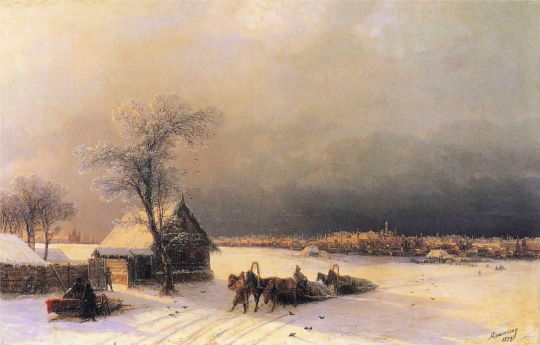
Moscow in Winter from the Sparrow Hills
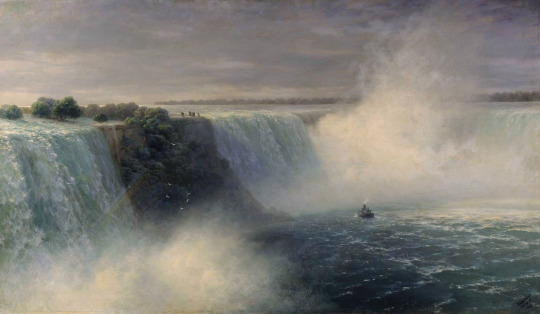
Niagara Falls 1892

Winter Landscape
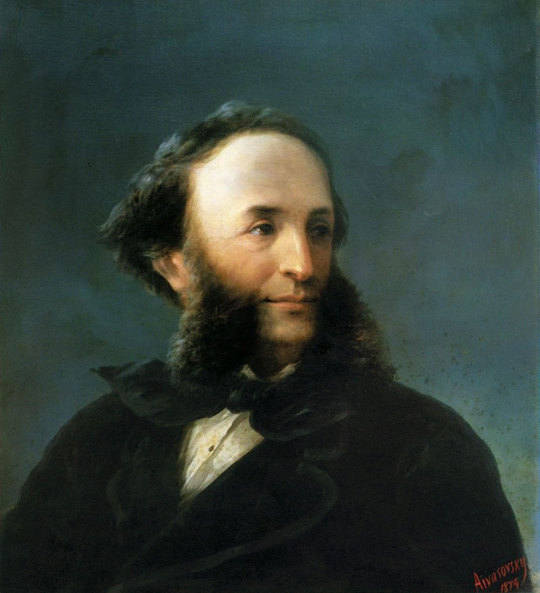

Self-Portrait, Portrait of the Artist's Wife Anna Burnazyan
@torc87 — I just did a 3am dash through his Wikipedia entry, which is of course only as good as the randos who edit it.  please feel free to offer your own thoughts,favorite images, or corrections!
77 notes
·
View notes
Text
Georgios Pachymeres: The Life of a Palaiologan Scholar

Georgios Pachymeres' father was part of the large group of Byzantines who fled the capital of the Eastern Roman Empire, Constantinople, after the Latin conquest of 1204 during the Fourth Crusade. He sought refuge with the Laskarid dynasty in Nicaea, one of the Byzantine successor states, where Georgios is believed to have been born around 1242. Here, the Laskarid dynasty prospered, ensuring a pleasant childhood for Georgios. In his historiographical work, nostalgia for this period often resonates in the form of criticism directed at emperor Michael VIII (r. 1261-1282), who neglected the situation in Asia Minor.
Georgios had a wealthy father who could afford to provide his son with a solid and broad education. When Michael VIII recaptured Constantinople in 1261, Pachymeres followed the new emperor to the ancient capital of Byzantium. There, he continued his higher studies, although the details remain unclear. It is generally assumed that his teachers were Georgios of Cyprus and Georgios Akropolites (1217–1282). Akropolites was a gifted writer and diplomat who became a central figure in the revival of higher education in Constantinople. Pachymeres undoubtedly had much to learn from him. Akropolites was a specialist in rhetoric, the quadrivium, and philosophy—fields in which Pachymeres would later excel.
Pachymeres demonstrated an exceptionally strong knowledge of both religious and secular law, which increased his chances of securing a lucrative position within the patriarchate or the court. Indeed, he quickly found his way into imperial circles and joined the ranks of the Constantinopolitan clergy.
His ecclesiastical career began in 1265 when he was ordained as a deacon of the Hagia Sophia, the center of Orthodox faith. His intellectual abilities were clearly appreciated, as evidenced by his appointment in 1277 as didaskalos tou apostolou, a position in which he was responsible for providing commentaries on the letters of the Bible and the Acts of the Apostles. In 1285, he was appointed hieromnemon, a role that made him responsible for various ecclesiastical matters, including priestly ordinations. One of the highlights of his career was his appointment as protekdikos in the same year, an influential role within the ecclesiastical court. Additionally, he utilized his knowledge of secular law to attain the position of dikaiophylax, an imperial judge. These high-ranking positions brought him into contact with several prominent figures, including members of the imperial family, Ioannes Bekkos, Athanasios II of Alexandria, and Theodosios Prinkips.
In addition to these responsibilities, Georgios also demonstrated a remarkable talent for the liberal arts. During this time, higher education and the academic world experienced a flourishing period in the newly reconquered capital, thanks in part to the efforts of the aforementioned Akropolites. The "dark" 13th century gave way to the so-called Palaiologan Renaissance, a revival of the Greek intellectual world and the arts. A significant milestone was the reopening of the Patriarchal Academy which was closed after the Latin conquest.
In other words, Constantinople offered ample opportunities for intellectuals with pedagogical talent. That Pachymeres excelled in teaching challenging subjects is evident from his literary work, which will be discussed in part 2. He earned his living as an instructor at the renowned Patriarchal Academy. More specifically, he held the position of oikonomikos didaskalos until 1275. In this role, he earned the respect of his colleagues and students. His significant contribution to the Palaiologan Renaissance cannot be overstated.
As a professor, he taught philosophy and the quadrivium. It is possible that he also taught rhetoric, although this is not certain. The quadrivium comprised the second and final series of the septem artes liberales: geometry, music, astronomy, and arithmetic. It is often assumed that his work, the Quadrivium (see part 2), served as support for his lessons. In any case, he had a significant influence on the later study of these subjects.
During his philosophy lessons, he covered the two major traditions of antiquity: Plato and the (Neo-)Platonic tradition on one hand, and Aristotle on the other. His autograph manuscripts reveal a particular interest in relatively rare commentaries on Plato and Neo-Platonic scholars. For his courses on Aristotle, he wrote an extensive summary of Aristotle's works in 12 books, the Philosophia (see part 2). He held immense admiration for Aristotle.
According to Pachymeres, Aristotle's genius lay in his apparent anticipation of many Christian doctrines. Specialist Pantelis Golitsis situates this idea within the context of the polemic over the question of how best to reach God.
The monastic movement, which gathered around Patriarch Athanasios (r. 1289-1293; 1303-1309), believed that a monastic lifestyle was the only correct way to draw closer to God. These fundamentalists sought to impose this idea on the rest of the clergy. This movement, better known as Hesychasm, partly originated in the theology of the famous Gregorios Palamas. They stubbornly opposed any philosophical rationalism in the approach to God.
Pachymeres, on the other hand, believed in an alternative path to a divine experience: through philosophy. Understanding God's creation was also a legitimate form of devotion. In this way, he sought to give the ancient philosophy, which he cherished, a more accepted place within Byzantine society.
According to Arnakis, this attitude of Pachymeres is more understandable in the context of the new proto-nationalist trend among the Byzantines, where they no longer considered themselves solely as Romans, but also as Hellēnes, without the term necessarily carrying a pejorative or pagan connotation. The intellectual elite of Constantinople was well aware of the significant contributions of their fellow speakers to world history and was proud of this. Pachymeres’ love for and teaching of Aristotle and Platonism, therefore, according to Arnakis, can be seen as part of this development.
Judging from what has been said, it might be tempting for the sensationalist to unmask Pachymeres, like Plethon, as a pagan in Christian garb. However, this is unlikely. Nowhere in his works do we detect anti-Christian ideas. One of his poems (at the end of his commentary on Aristotle's Fysika) attests to his unwavering devotion to Christ and God. Likewise, in his Quadrivium, he claims that the salvation of mankind depends on God's grace. In his work, we also find other traditional Christian beliefs, such as the salvation found in the sacraments and the inherent weakness of humanity. Interestingly, he often supports the latter claim with references to ancient, pagan authors. This leads us to the next issue: to what extent are these professions of faith sincere? This question may give rise to endless discussions, but a final judgment is beyond the realm of possibility. In any case, Pachymeres sought to present himself as a traditional, orthodox Greek.
Yet, there is something innovative about Pachymeres. His attitude is reminiscent of that of the Italian humanists. By encouraging philosophy, he assigns a greater responsibility to humanity in creation. The idea that the Byzantines were the forerunners of the European Renaissance is a stance defended by many Byzantinists. Indeed, a certain Christian anthropocentrism characterizes Pachymeres, which, although it ends with God, begins with humanity.
We know a lot about his public life thanks to the various autobiographical elements in his works. However, he remains silent about his personal life. It is generally believed that Pachymeres died in the year 1310 at the age of 65. The cause of death remains a mystery. His friend Manuel Philès wrote an epitaph for him, although the date of this remains uncertain. A portrait of Pachymeres has been preserved, but the reliability of its depiction is also questionable.
Olivier Goossens
#byzantine empire#byzantine art#byzantine#roman empire#roman art#roman history#greek history#greek literature#greek orthodox#medieval history#middle ages#manuscript
3 notes
·
View notes
Text
Saints&Reading: Thursday, June 15, 2023
june 16_june 2
SAINT NICEPHOROS the CONFESSOR PATRIARCH of CONSTANTINOPLE ( 829)
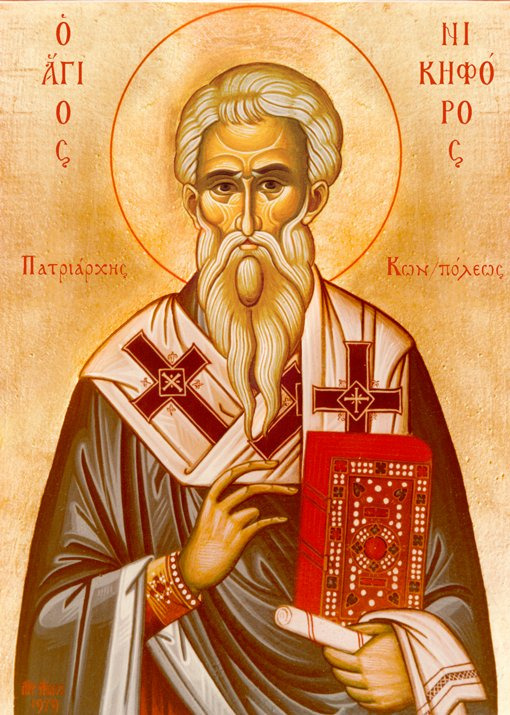
Saint Nikēphóros was a dignitary at the court of Empress Irene (797-802). After embracing monasticism, he became widely known for his piety. He assumed the Patriarchal Throne of Constantinople in 806 and became a zealous defender of the holy Icons. In 815, the Iconoclast Emperor Leo the Armenian (813-820) exiled him to Prokonnis, where he fell asleep in the Lord in 828.
Saint Nikēphóros left behind three writings against Iconoclasm.
In 846, the relics of Patriarch Nikēphóros were returned to Constantinople and placed in the Great Church of Hagia Sophia for one day before being transferred to and enshrined in the Church of the Holy Apostles.
SAINTS BLANDINA and PONTICUS OF LYONS (Gaul_177)

Their early date, the factual and moving contemporary record, faithfully transcribed by Eusebius and their subsequent cult, make these protomartyrs of Gaul altogether notable. Like many elsewhere, they suffered in the persecution of Marcus Aurelius (161–80). One of the most exciting features of the account is how the varied personnel of the martyrs is stressed: bishops, priests, deacons and laity, men and women, slave and free. Some of them had come from the nearby church of Vienne. The account was written for the churches of Asia and Phrygia, from which some of these congregations had come. At the same time, Irenaeus, the future bishop of Lyons, also took a copy to Eleutherius, bishop of Rome.
The document begins: ‘The severity of our trials here, the unbridled fury of the heathen against God's people, the untold sufferings of the blessed martyrs, we are incapable of describing in detail: indeed no pen could do them justice.’ Persecution had begun with social ostracism (exclusion from the market and the baths), it continued with popular violence (insults, blows, thefts, and stonings), and ended with official action. This brought Christians to the forum for interrogation and subsequent imprisonment. One young man called Vettius Epagathus asked to defend them against charges of treason and impiety. The judge then asked if he too, were a Christian. When he answered that he was, he was also sent to prison. At this point the pressure was so intense that ten Christians abjured.
The next move was to arrest the slaves of Christians. Some of these accused their masters of cannibalism, incest, and other abominations. The mob's fury was then directed against Sanctus, a Vienne deacon who, under repeated torture and interrogation, answered only: ‘I am a Christian.’ Blandina, a slave, showed fortitude unexpectedly by her mistress. The aged bishop of Lyons, Pothinus, reputed to be aged ninety (Polycarp was claimed to be eighty-six) also suffered like the others. When asked to explain who was the God of the Christians, he replied: ‘If you are worthy, you will know.’ He was then beaten, kicked, and stoned until he was unconscious. Two days later, he died in prison.
The martyrs were killed in more ways than one. At least four were killed by wild beasts in the surviving amphitheater; others were tortured with whips or roasted on the iron chair. Others died as a result of their varied sufferings. These tortures were repeated in some cases. Other lethal factors were the brutality of the jailers and the bad conditions of imprisonment. The courage of the martyrs never faltered, but they also helped to reconcile those who had failed to be constant. The emperor's rescript condemned Christians to death but ordered the release of those who had abjured. This, however, was the occasion for the lapsed to confess Christ boldly and join the other martyrs.
On the last day of the ‘single combats’ Blandina was again brought into the amphitheatre with a boy of fifteen called Ponticus. After he had endured every torment, he died. Blandina was thrown into a net and exposed to a bull. When she had been repeatedly tossed, she became unconscious but by no means unfaithful under the fatal goring. She, too, ‘upheld by her faith and communing with Christ, was immolated…the pagans themselves admitted they had never known a woman to show such endurance.’
Source: Oxford Reference

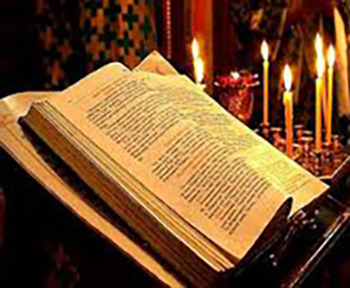
ROMANS 5:10-16
10 For if when we were enemies we were reconciled to God through the death of His Son, much more, having been reconciled, we shall be saved by His life. 11 And not only that, but we also rejoice in God through our Lord Jesus Christ, through whom we have now received the reconciliation. 12 Therefore, just as through one man sin entered the world, and death through sin, and thus death spread to all men because all sinned- 13 (Until the law sin was in the world, but sin is not imputed when there is no law. 14 Nevertheless, death reigned from Adam to Moses, even over those who had not sinned according to the likeness of the transgression of Adam, who is a type of Him who was to come. 15 But the free gift is not like the offense. For if by the one man's offense, many died, much more the grace of God and the gift by the grace of the one Man, Jesus Christ, abounded to many. 16 The gift is not like that which came through the one who sinned. The judgment from one offense resulted in condemnation, but the free gift from many crimes resulted in justification.
MATTHEW 8:23-27
23 when He got into a boat, His disciples followed Him. 24 And suddenly a great tempest arose on the sea, so the boat was covered with the waves. But He was asleep. 25 Then His disciples came to Him and awoke Him, saying, "Lord, save us! We are perishing!" 26 But He said to them, "Why are you fearful, O you of little faith?" Then He arose and rebuked the winds and the sea, and there was a great calm. 27 So the men marveled, saying, "Who can this be, that even the winds and the sea obey Him?"
#orthodoxy#orthodox christianity#easternorthodoxchurch#originofchristianity#spirituality#holyscriptures#bible#gospel
7 notes
·
View notes
Text
Theodora: A Summary
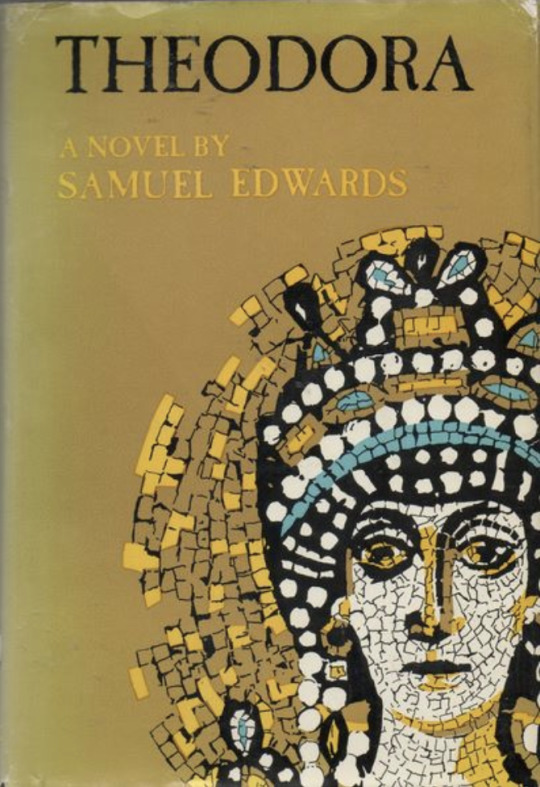
So, a few months ago, I decided to torment myself by reading Theodora by Samuel Edwards, a deeply questionable "vintage" novel from 1969 that, in many ways, makes Robert Graves's Count Belisarius look tame. I did a whole summary of it that I never posted because it got too long and unwieldy, but I got bored this past weekend, so I went back and edited it down to bullet points and individual sub-parts for more readability. So, if you're interested in Highly Questionable Byzantine Shennanigans, here goes:
The book starts off normally enough, detailing the gossip circulating around Constantinople in the weeks before Justinian and Theodora’s engagement. It quickly introduces several important characters by basically just listing their names and their thoughts about Theodora; predictably, the patricians all dislike her, the other courtesans are all jealous of her, the Monophysite clergy love her because she’s championing their cause, and Belisarius has no opinion whatsoever about her because he’s too loyal to Justinian to give a shit about his romantic entanglements. And *then* the book introduces Narses, and it immediately gets weird. Basically, Narses is sexually attracted to Justinian, to the point of having frequent erotic fantasies about him, and he’s therefore disappointed upon hearing of Justinian’s courtship with Theodora. This is a one-off sentence or two in the intro, but don’t worry, Narses’s crush on Justinian (and general sexual deviancy) will become a major recurring theme. So we’re already off to a great start.
The reader is then introduced to Justinian, who is quickly established as a.) mysterious, b.) devoted to his work, and c.) completely fucking insane. We are told that he only sleeps 3 hours a night and frequently goes 72 hours without rest, and is still somehow completely functional, so “the sleepless one” is a literal moniker. He’s also, inexplicably, a talented swordsman (this never comes up again) who’s so strong that he can walk around without guards because he can defend himself using his sheer physical prowess, and he recently graduated college, having completed fourteen years of coursework in five years. Basically, he’s amazing at everything to an absolutely ludicrous degree. The reader meets him in a flashback to the night he first met Theodora, so he’s presently very lonely, wandering Constantinople and pondering the emptiness of his heart.
It isn’t long before Justinian, still lonely and sexually dissatisfied, goes to the Hagia Sophia to seek life advice from God. Of course, Theodora is in the Hagia Sophia, and he’s instantaneously attracted to her, because of course he is. We are told that Theodora has long black hair and purple eyes like a teenage girl’s OC, her waist is so tiny that Justinian can encircle it in his hands, and she looks much younger than she is (it takes Justinian a while to realize that she’s in her twenties and not, in fact, sixteen. Her apparent youth, of course, makes her more attractive to him.) When Justinian first notices her, she’s reading a book, and he finds this astonishing. So astonishing, in fact, that he basically just walks up to her and demands that she read some lines aloud to him in order to prove that she’s actually reading and not just, I don’t know, quietly staring at paper. So she reads him a paragraph or so, but he’s still not satisfied, so he makes her translate some more lines for him, and it’s just kind of exhausting. Justinian really comes across as, like, an angry nerd who walks up to a girl wearing a Star Wars T-shirt and goes “oh, you like Star Wars? Prove it by answering my trivia!” But Theodora indulges him, then they get into an argument about the divine nature of Christ, and she’s so charmed by his shitty attitude that she decides to follow him home.
We are then introduced to Justinian’s house, which is a decrepit hovel that desperately needs a woman to make it into A Home. (Obviously, Theodora is that woman.) She makes Justinian dinner because he’s too inept to feed himself, Justinian infodumps to her about bread, and then he gets called away to some meeting. When he returns from his meeting, he discovers that Theodora has miraculously transformed his terrible house into a habitable environment, then fallen asleep on his couch. So he decides to let her stay, and she basically moves in with him (having known him for a sum total of a few hours). It has the same energy as, like, someone bringing home a stray alley cat, then adopting the cat because it turns out to be really good at interior decorating.
The next morning, Theodora has someone make Justinian his favorite stew, and he’s like “HOW DID YOU KNOW THIS IS MY FAVORITE?” and she’s like “idk, it was a lucky guess :)” But then the narration reveals that she has been obsessively targeting Justinian for weeks, noting all of his movements in the hopes of attracting him and ending up as his mistress, and, as part of her campaign to worm her way into his heart, she’s been following workmen from the same region as him and observing what they eat so she could use that knowledge to make Justinian meals that remind him of his childhood. Which is so incredibly Machiavellian that it kind of circles back around to being amazing. I mean, that’s delusional stalker behavior, but I respect it!
It turns out that Theodora also has access to some important intel about the general Vitalian, which she got by, idk, being a courtesan and knowing things, and right after she admits this to Justinian, Narses and Belisarius conveniently show up with a problem regarding Vitalian. Theodora is able to fix the problem (to Narses’s envy) and Justinian is so happy about this that he gives her some expensive jewelry, which makes her cry. The entire time she’s crying, he just hovers over her and does nothing, like a creep. And then they have sex, because there’s nothing sexier than crying.
They start living as a couple, obviously, but Theodora quickly becomes kind of a homebody, refusing to leave the house or go outside for any reason. This is obviously weird and abnormal, and Justinian is unnerved by it, so he asks her what’s up. Lo and behold, the issue is the Prostitute Dress Code.
What is the Prostitute Dress Code, you ask? Well, it’s a bizarre, inexplicable, completely ahistorical set of rules that governs what color socks prostitutes can wear. Prostitutes of a certain rank have to wear a ridiculous yellow outfit, and prostitutes of another rank have to wear a ridiculous red outfit, and you can be upgraded from a yellow prostitute to a red prostitute, and it’s all just really stupid. And that’s why Theodora doesn’t want to go outside. Because she’d have to wear red socks. I don’t know.
(As an aside, Theodora has been wearing red and purple this entire time. She was introduced in chapter one wearing purple, even though she was a penniless prostitute at the time. Which kind of takes the bite out of “purple is the noblest shroud,” right? If everyone can wear purple whenever they want, and purple has no special significance to her beyond being pretty and fun, her whole speech becomes kind of meaningless.)
Anyway, Theodora doesn’t want to wear the Prostitute Socks, but she doesn’t want to *not* wear the Prostitute Socks because that would mean breaking the law, and this leads to an argument between her and Justinian, which culminates in him proposing to her. As one does.
That concludes the courtship and falling-in-love montage! If you're thinking "this relationship sounds shaky and Justinian sounds very unpleasant," hold on to your stolas; it gets worse in part two.
5 notes
·
View notes
Text
Places to Visit in Hagia Sophia
Nestled in the heart of Istanbul, Turkey, Hagia Sophia stands as an architectural marvel and a testament to the intersection of history, culture, and religion. Originally built as a Byzantine cathedral in the 6th century, it later transformed into an imperial mosque during the Ottoman era, and today, it stands as a cherished museum, captivating millions of visitors from across the globe. This article will take you on a mesmerizing journey through the historical significance, architectural wonders, and cultural heritage of Hagia Sophia Museum. 1. The Historical Significance: Hagia Sophia, known as Ayasofya in Turkish, holds an unparalleled historical significance. It was commissioned by Emperor Justinian I in 537 AD and remained the largest cathedral in the world for nearly a thousand years. The edifice served as the principal religious center of Eastern Christianity for centuries, witnessing numerous imperial coronations and religious ceremonies.
2. The Architectural Marvel: Hagia Sophia's architectural brilliance lies in its unique blend of Byzantine and Ottoman design elements. The massive dome, an engineering marvel of its time, symbolizes the grandeur of the Byzantine era. The dome appears to float effortlessly, supported by an innovative system of pendentives. The interior is adorned with intricate mosaics, depicting religious figures and events from Christianity's early history, adding to the cathedral's splendor.
3. Transformation into a Mosque: With the conquest of Constantinople by the Ottoman Sultan Mehmed II in 1453, Hagia Sophia underwent a significant transformation. The cathedral was converted into an imperial mosque, and Islamic architectural elements were integrated, including the addition of minarets and the construction of the mihrab and minbar. Despite these changes, many of the original Christian mosaics were preserved, underscoring the structure's unique historical duality.
4. The Call to Prayer and Its Melody: For nearly five centuries, Hagia Sophia resounded with the Islamic call to prayer, a captivating melody that echoed through the vast interior. The juxtaposition of the Arabic calligraphic inscriptions alongside the Byzantine mosaics created a harmonious blend of religious expressions, symbolizing Istanbul's multicultural heritage.
5. Transformation into a Museum: In 1935, under the orders of Turkey's visionary leader, Mustafa Kemal Atatürk, Hagia Sophia was transformed into a museum as part of the country's modernization efforts. This decision aimed to preserve the cultural heritage of the monument and transform it into a symbol of unity, open to people of all faiths and backgrounds.
6. The Interior Splendor: Step inside Hagia Sophia Museum, and you will be awe-struck by the grandeur that awaits. The vast central nave leads the eye upward to the stunning dome, adorned with Islamic calligraphy. Wander through the galleries to admire the breathtaking mosaics and frescoes that depict biblical scenes, saints, and emperors. Each intricate detail is a testament to the skilled craftsmanship of the artisans of bygone eras.
7. The Omphalion: One of the most fascinating features within the museum is the Omphalion, a circular marble slab at the center of the building. It marks the spot where Byzantine emperors were crowned and is steeped in historical and spiritual significance. Visitors often stand on this sacred spot, contemplating the weight of history beneath their feet. Suggested Read: Hagia Sophia: A UNESCO World Heritage Site and Turkey’s Jewel in the Crown
8. The Tombs and Library: Hagia Sophia Museum houses the final resting places of several Ottoman Sultans and their families. These beautifully decorated tombs provide a glimpse into the opulent lifestyle of the Ottoman rulers. Additionally, the museum boasts a library that contains a vast collection of rare manuscripts and religious texts, making it a treasure trove for researchers and scholars.
Conclusion:
Hagia Sophia Museum stands as a living testament to the richness of human history and the intermingling of cultures through the ages. Its awe-inspiring architecture, historical significance, and cultural heritage have earned it the distinction of being a UNESCO World Heritage Site. As you traverse the halls of this magnificent structure, you will be transported through time, experiencing the echoes of civilizations that have left an indelible mark on Istanbul's landscape. Hagia Sophia Museum is not merely a destination; it is a journey into the heart and soul of humanity.
2 notes
·
View notes
Text
Experiencing Istanbul Through Photography
Maréva U, GABAM-ANAMED Post-Doctoral Fellow (2022–2023)

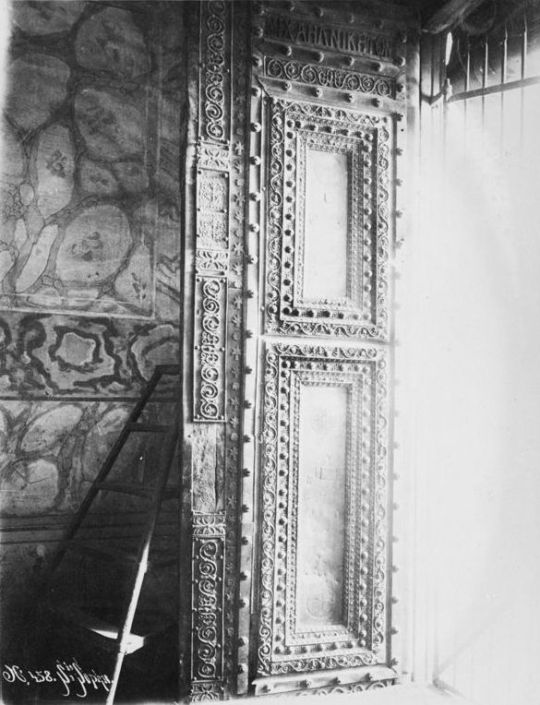
Fig. 1. Istanbul, street leading up to the Galata Tower (photo by Albert Kahn, 1913, No. A2307S, Albert Kahn Museum). Fig. 2. Istanbul, Hagia Sophia, bronze door (photo by Gabriel Millet, Photo Archives, EPHE).
Photography is a technical and mechanical means of preserving a graphic representation of places, monuments, objects, people, and moments. It can be used as a historical testimony—an approach taken, for example, by the French banker and philanthropist Albert Kahn in his attempt to create the Archives of the Planet between 1908 and 1931[1]—or as a research and documentation tool—an approach we adopt in the humanities and social sciences, as evidenced by the photographs of monuments taken by the Byzantinist Gabriel Millet in the late nineteenth and early twentieth centuries.[2] Photography is also a means of expression that bears the signature of its author and whose objectivity is equal to any artistic work.
However, for several decades, photography has become, in the words of the sociologist Pierre Bourdieu, a “popular art.”[3] Film cameras and the slow and complex process of developing photographs have given way to digital cameras and smartphones capable of capturing, in high definition, fixed images of our private lives and our travels. These digital tools allow for easy and instantaneous snapshots. They lead us, in a consumerist way, to take an unlimited number of images, most of which are stored indefinitely in our smartphones or computers, without much consideration.
Photography is today overexploited and tends to be conditioned by the dominant visual discourses conveyed by the vast media landscape. These discourses construct cultural codes that define the value of a place, transforming a specific site into an appreciable, visitable, or unmissable and “instagrammable” place. The same places and monuments of Istanbul, as in any tourist city, become the subject of countless photographs, or rather the background in front of which people pose in their best light. These stereotypical photographs, whose colors are often oversaturated by smartphone filters that alter our perception of reality, flood the internet and social media. Unconsciously, these discourses and images influence the way we perceive, experience, and photograph places.
Since my arrival at ANAMED, I have wanted to build my own experience and perception of Istanbul, trying to detach myself from these visual dictates (the choice of black and white photography is partly a result of this intention). My research on the experience of the architectural space of Byzantine monuments has undoubtedly influenced my relationship to the city and to photography. Of course, the architecture of the Byzantine buildings attracted most of my attention.
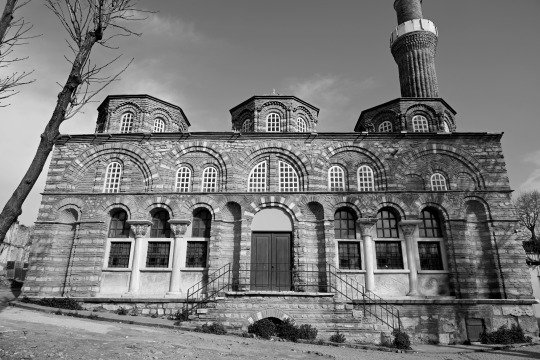

Fig. 3. Vefa Kilise Camii, western façade (photo by the author). Fig. 4: Küçük Ayasofya Camii (St. Sergius and Bacchus), columns and capitals (photo by the author).
Beyond photographic documentation, it is possible to look at and photograph the monuments we visit and study in a different way, especially by examining how they are integrated into the modern cityscape and how people use their spaces today. In doing so, details such as the contrast between the recently restored Tekfur Sarayı and the nearby pile of rubble, the calmness of a man praying in Fenari Isa Camii (Constantine Lips Monastery), or the movement of a child playing ball in front of Zeyrek Camii (Pantokrator Monastery) can attract our attention.
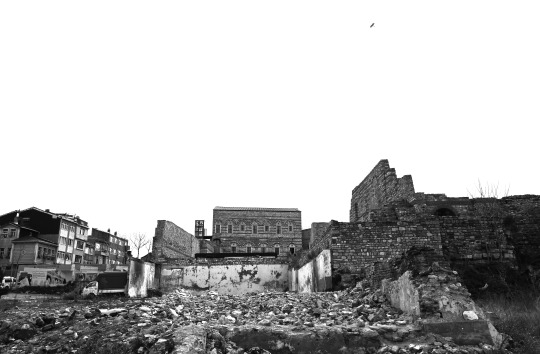
Fig. 5. Tekfur Sarayı (photo by the author).


Fig. 6. Man in Fenari Isa Camii (Constantine Lips Monastery) (photo by the author). Fig. 7. Child in front of Zeyrek Camii (Pantokrator Monastery) (photo by the author).
Besides Byzantine and Ottoman architectural heritage, Istanbul’s vibrant and colorful urban space deserves more attention. Istiklal Caddesi, which is difficult to avoid if you live in ANAMED, is passed by thousands of people every day. Many of them take selfies and pictures of each other or walk around with their smartphones in hand, continuously filming the hustle and bustle of the street, probably without really paying attention to the urban space. To experience it and to photograph it, it is necessary to slow down, to stop, to turn around, and to look up above the sometimes-oppressive crowd to observe and capture, for example, some architectural details or a man discreetly watching urban life from his window.

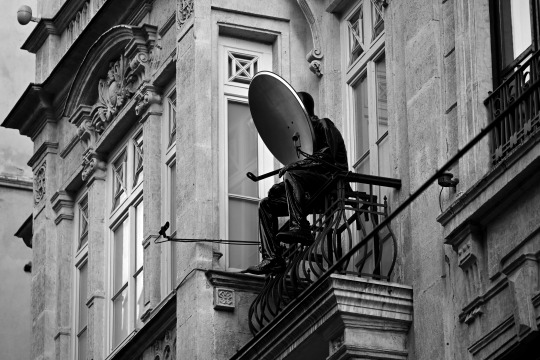
Fig. 8. Istiklal Caddesi (photo by the author). Fig. 9. Istiklal Caddesi (photo by the author).
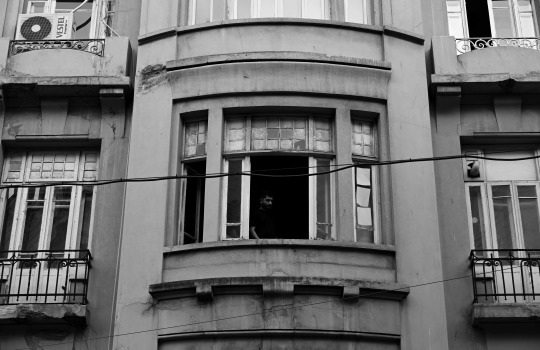
Fig. 10. Sıraselviler Caddesi (photo by the author).
To experience Istanbul through photography, it is necessary to voluntarily lose oneself in the city and to be open to possibilities, opportunities, unexpected events, and encounters. In this way, it is possible to observe space, architecture, scenes of everyday life, people’s attitudes, spontaneous movements, effects of light and shadow. In short, the practice of photography allows us to see what is attractive and visible but also to pay attention to what is ordinary and sometimes hidden or invisible. Such an approach to the city can sometimes be uncomfortable, as it puts us in a contradictory position: between a voyeur, eager for aesthetic visuals, and a detached onlooker, aware of the various aspects of a place and its atmosphere. By unknowingly photographing children playing in the street, a man painfully carrying a washing machine, or a woman sitting on a bench focused on her phone, I experienced this ambivalent situation myself. Photography can thus lead us to question our relationships with others and sometimes to overcome our fears of rejection when we ask permission to take someone’s picture.
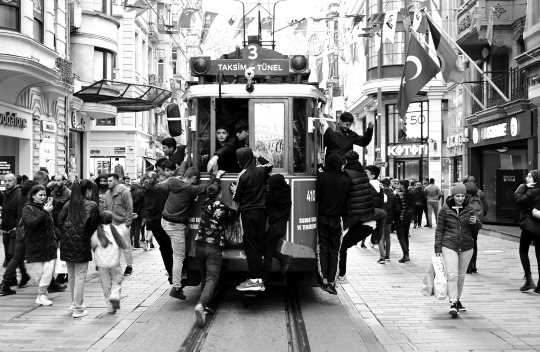

Fig. 11. Tünel, Istiklal Caddesi (photo by the author). Fig. 12. Children, Balat (photo by the author).

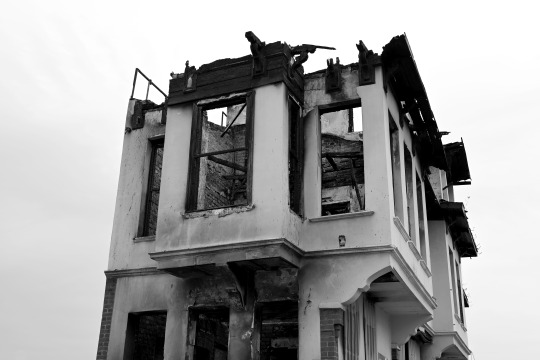
Fig. 13. House, Fatih (photo by the author). Fig. 14. House, Fatih (photo by the author).

Fig. 15. Man, Fatih (photo by the author).
The act of photography, in my opinion, has other effects on the person who practices it. It teaches us patience in order to capture the desired image, a quality we often lack in our productivity-driven society. Experiencing urban space through photography can allow us to take a break from the frenetic pace of our academic lives, as it leads us to develop an alternative conception of space and time.


Fig. 16. Cat, Fatih (photo by the author). Fig. 17. Woman, Taksim (photo by the author).
Therefore, photography is not just a matter of pressing a button to mechanically fix a part of the urban space and its inhabitants in an image. By walking around, looking for photographable objects and framing them, we appropriate the space and try to give a meaning to what we see. Photography can then be used by anyone (with a camera or a smartphone) to record their own experience of space, to visualize their perceptions and engagements with the place, or to explore their aesthetic and expressive capacities.
----------------------------------------------------------------------------------------------------------------------------------------------------
[1] https://albert-kahn.hauts-de-seine.fr/en/collections/presentation/a-documentation-project-for-the-world/the-archives-de-la-planete.
[2] https://explore.psl.eu/fr/ressources-et-savoirs-psl/projets-psl-explore/la-phototheque-gabriel-millet-ecole-pratique-des.
[3] Bourdieu, Pierre, ed., Un art moyen : essai sur les usages sociaux de la photographie (Paris: Les Editions de Minuit, 1965).
6 notes
·
View notes
Text
Discover the Top 10 Must-Visit Spots in Turkey for 2025
Looking for the best travel deals on flights, hotels, and activities? ✈️🏖️ With Trip, you get exclusive discounts, hassle-free booking, and 24/7 customer support to make your trip unforgettable!
✨ Special Offer: Sign up now and unlock amazing travel deals worldwide! 👉 Join Trip.com here
Don’t miss out — your dream vacation is just a click away! 🌍💙
Turkey is a vibrant nation that blends rich history with stunning natural beauty. It’s one of the best places in Turkey to explore. As we look ahead to 2025, travelers can expect amazing experiences.

Key Takeaways
Explore Istanbul for its rich history, nightlife, and shopping experiences.
Antalya is renowned for its beautiful beach resorts, ideal for summer vacations.
Don’t miss the ancient city of Ephesus, a UNESCO World Heritage Site that highlights Turkey’s historical significance.
Cappadocia offers breathtaking views from hot air balloon rides over its fairy chimneys.
Take advantage of Turkey’s delectable cuisine, including famous dishes from Gaziantep.
Introduction to Turkey’s Diverse Attractions
Turkey is a land of contrasts, blending rich history with stunning natural landscapes. A travel guide to Turkey reveals a tapestry of attractions for all interests. Visitors can explore ancient ruins, vibrant cities, and idyllic beaches, making turkey travel a multifaceted experience. Each destination has its unique charm, from bustling Istanbul to breathtaking Cappadocia.
The variety of experiences includes outdoor adventures and culinary delights. This showcases why Turkey is a top travel choice in 2025. Turkey itinerary suggestions often highlight popular spots, such as Pamukkale’s thermal waters and the renowned hot air balloon rides of Cappadocia, providing travelers with unforgettable memories. According to recent reviews, approximately 20% of tourists emphasize Istanbul’s historical sites including the iconic Grand Bazaar, illustrating the city’s cultural significance.
In more than 335 reviews, travelers praised Turkey for its organizational excellence, with 30% expressing satisfaction with their guided tours. This attention to detail ensures that each traveler can explore Turkey without hassle, enabling the discovery of over 20 unique experiences. Enthusiastic reviews reflect the seamless blend of history and nature, captivating around 25% of visitors. With a favorable climate and renowned hospitality, Turkey remains an enchanting destination for anyone eager to embark on an extraordinary journey.
Looking for the best travel deals on flights, hotels, and activities? ✈️🏖️ With Trip, you get exclusive discounts, hassle-free booking, and 24/7 customer support to make your trip unforgettable!
✨ Special Offer: Sign up now and unlock amazing travel deals worldwide! 👉 Join Trip.com here
Don’t miss out — your dream vacation is just a click away! 🌍💙
Exploring Istanbul: A Cultural Crossroads
Istanbul is a stunning example of cultural blending. It’s one of Turkey’s best spots, with a mix of old history and new life. Every year, millions of people visit, making it a top choice for tourists. In 2023, 17 million international visitors came, showing its charm.
Historical Highlights: Hagia Sophia and Blue Mosque
Hagia Sophia tells Istanbul’s story. Built as a church in 537 AD, it became a mosque and now is a museum. It’s a symbol of the city’s deep history.
The Blue Mosque, next to Hagia Sophia, is known for its blue tiles and six minarets. It shows the spiritual side of the area. These landmarks give a peek into Istanbul’s rich cultural past.
Vibrant Neighborhoods: Sultanahmet and Balat
Sultanahmet and Balat show Istanbul’s heart. Sultanahmet is full of history and markets. Balat, with its colorful houses and artists, is lively and enchanting.
Visiting these areas offers real experiences. You can try Turkish food and buy local crafts. These neighborhoods capture the spirit of Turkey.
Bodrum: The Aegean Jewel
Bodrum is a top spot in Turkey, blending history with beautiful coastlines. It was once known as Halicarnassus, a city full of life and history. Here, you can see ancient ruins, enjoy the beaches, and dance the night away.
Ancient Ruins: Bodrum Castle and Halicarnassus
Bodrum’s history shines through its ancient sites, like Bodrum Castle and Halicarnassus. Bodrum Castle, a medieval fortress, offers stunning views and houses a museum. The ruins of Halicarnassus, a wonder of the ancient world, attract history lovers. Visiting these places is key to understanding Turkey’s past.
Beaches and Nightlife: Enjoying the Coastal Vibes
Bodrum’s beaches are some of Turkey’s most stunning, perfect for relaxation or sports. As night falls, Bodrum comes alive with clubs and bars. Bar Street is a highlight for those who love to party under the stars. Bodrum’s mix of history and modern fun makes it a top vacation spot.
Cappadocia: A Natural Wonder
Cappadocia is a top spot in Turkey, known for its amazing landscapes. It’s home to fairy chimneys, formed by volcanoes and erosion over time. This place is perfect for those who love nature and adventure, offering a mix of history, culture, and beauty.
Fairy Chimneys: Unique Rock Formations
The fairy chimneys in Cappadocia attract millions every year. They create a magical setting, great for photos and exploring. Trails let visitors enjoy the scenery at their own speed.
Hot Air Balloon Adventures: Breathtaking Views
Hot air balloon rides in Cappadocia are unforgettable. At dawn, over 100 balloons fill the sky, offering stunning views. The rides are safe, making them a great way to see Turkey’s beauty.

Looking for the best travel deals on flights, hotels, and activities? ✈️🏖️ With Trip, you get exclusive discounts, hassle-free booking, and 24/7 customer support to make your trip unforgettable!
✨ Special Offer: Sign up now and unlock amazing travel deals worldwide! 👉 Join Trip.com here
Don’t miss out — your dream vacation is just a click away! 🌍💙
Cappadocia is not just about nature; it’s also rich in culture. The Göreme Open-Air Museum is a UNESCO site with ancient cave churches and frescoes. There are many places to stay, from luxury hotels to hostels, and delicious local food to try. It’s a place with something for everyone, from hiking to hot air balloon rides.
Antalya: The Mediterranean Gem
Antalya is a top spot in Turkey, loved for its beautiful beaches and history. It has amazing sights like Hadrian’s Gate, built in 130 AD for Roman Emperor Hadrian. The old town, Kaleiçi, has narrow streets and Ottoman buildings, plus a lovely marina for a relaxing day.
Konyaaltı Beach is long and wide, perfect for sunbathing. You can rent sun loungers and umbrellas for €5 to €10. For thrill-seekers, the Düden Waterfalls are a must-see. They have two parts: the Upper Düden with a park and entrance fees of €1 to €2, and the Lower Düden for boat tours at €15 to €25.
Köprülü Canyon National Park is a nature lover’s dream. It’s huge, with 366 square kilometers of rafting and stunning views. The park’s walls are high, making it great for outdoor fun. It’s also a place for conservation and home to many animals, making it a top spot for vacations.
Top 10 Must-Visit Places in Turkey for 2025: A Traveler’s Paradise
Turkey is a treasure trove of history and natural wonders. The top 10 places to visit in Turkey for 2025 are a true paradise for travelers. With tourism expected to grow by 10%, about 60 million visitors will explore its beauty by 2025.
In Istanbul, landmarks like the Hagia Sophia and the Blue Mosque draw millions. The Hagia Sophia gets over 3.5 million visitors, and the Blue Mosque welcomes around 3 million. The Grand Bazaar, with over 4,000 shops, attracts about 15 million shoppers every year.
Cappadocia is famous for its fairy chimneys and hot air balloon rides. It welcomes about 2 million tourists yearly. Pamukkale’s thermal pools, known for their beauty and healing properties, attract roughly 1.5 million visitors annually.
The ancient ruins of Ephesus, one of the best-preserved ancient cities, see around 2 million tourists each year. Attractions like the Library of Celsus and the Temple of Artemis offer a glimpse into Turkey’s history.

Izmir: The Aegean Gateway
Izmir is Turkey’s third-most populous city and a gateway to the Aegean coast. It offers a mix of history and modern fun. Travelers can see ancient sites and enjoy the beaches, making it a top spot in Turkey.
Looking for the best travel deals on flights, hotels, and activities? ✈️🏖️ With Trip, you get exclusive discounts, hassle-free booking, and 24/7 customer support to make your trip unforgettable!
✨ Special Offer: Sign up now and unlock amazing travel deals worldwide! 👉 Join Trip.com here
Don’t miss out — your dream vacation is just a click away! 🌍💙
Historical Sites: Agora and Kadifekale
The ancient Agora of Izmir is a must-see. It was once a bustling marketplace. Nearby, Kadifekale offers views of the city’s growth over time.
Visiting these sites helps travelers understand Turkey’s history better.
Charming Beaches: Cesme and Alacati
Cesme and Alacati are close to the city and perfect for beach lovers. Cesme has beautiful shores and lively clubs. Alacati is known for its streets and calm vibe.
These places offer both relaxation and adventure, making them great for beachgoers.
Kas: Outdoor Adventures Await
Kas is a gem on Turkey’s Turquoise Coast, perfect for outdoor lovers. It mixes history with nature, offering a lively place to explore. The area’s beauty invites visitors to try many activities.
For those who love adventure, the Lycian Way is a must. This trail winds through ancient sites and beautiful views. It’s a great way to see the coast and the famous Lycian rock tombs.
For water lovers, Kas’s clear waters are ideal for diving. It’s also a top spot for paragliding, offering a unique view from above.

Oludeniz: Paradise on the Turquoise Coast
Oludeniz is a top spot in Turkey, known for its breathtaking beauty. It boasts the Blue Lagoon, with turquoise waters and soft sandy beaches. It’s a perfect place for swimming and sunbathing, offering a calm atmosphere.
But Oludeniz is more than just beaches. It’s a haven for water sports like paragliding and sailing. These activities offer stunning views of the coast. The mix of nature and modern amenities makes it a favorite among travelers.
Oludeniz is also a starting point for the Lycian Way hiking trail. This trail takes you through beautiful coastlines and ancient ruins. It’s great for adventure lovers, especially in quieter months like April and May. A trip to Oludeniz adds value to any Turkey travel plan.
Looking for the best travel deals on flights, hotels, and activities? ✈️🏖️ With Trip, you get exclusive discounts, hassle-free booking, and 24/7 customer support to make your trip unforgettable!
✨ Special Offer: Sign up now and unlock amazing travel deals worldwide! 👉 Join Trip.com here
Don’t miss out — your dream vacation is just a click away! 🌍💙
Exploring Ancient Ephesus
Ephesus is a top spot for history lovers, known worldwide for its ancient ruins. It’s a key destination for those traveling to Turkey in 2025. Here, you can see amazing architecture and historical sites that tell the story of its past.
The Library of Celsus: An Architectural Marvel
The Library of Celsus is a highlight in Ephesus. Its stunning design and facade are awe-inspiring. Built in the 2nd century AD, it once held 12,000 scrolls, making it a hub of knowledge.
The library’s design shows the Romans’ advanced engineering skills. It’s a must-see for anyone interested in Turkey’s history.
Other Key Sites: Temple of Artemis and Theatre
Don’t miss the Temple of Artemis, one of the Seven Wonders of the Ancient World. It’s huge, measuring 115 meters long and 55 meters wide. It shows the grandeur of ancient life.

Mount Nemrut: A Historical Marvel
Mount Nemrut is a symbol of Turkey’s deep history. It has ancient tumulus and huge statues of gods. This UNESCO World Heritage site is known for its architecture and draws those who want to explore Turkey deeply. Visitors are drawn to the stunning views from the top, especially at sunrise or sunset, showing some of the best places in Turkey.
The entrance fee for the East and West Terraces, and the combined ticket for the Tumulus and Terraces, is just $10. This makes it easy for people to visit turkey travel. While there, many try local food, like kebab houses with meals from $10 to $15. Others enjoy luxury dining at the Nemrut Restaurant, where meals cost between $15 and $20.
Visitors should wear good hiking shoes for the uneven terrain. The hike to Mount Nemrut takes about an hour. The best times to visit are spring or early summer, when the weather is nicer, making the experience even more special.
Looking for the best travel deals on flights, hotels, and activities? ✈️🏖️ With Trip, you get exclusive discounts, hassle-free booking, and 24/7 customer support to make your trip unforgettable!
✨ Special Offer: Sign up now and unlock amazing travel deals worldwide! 👉 Join Trip.com here
Don’t miss out — your dream vacation is just a click away! 🌍💙
Conclusion
Turkey is a treasure trove of attractions for 2025. It offers breathtaking views in Cappadocia and unique hot air balloon rides. You can also explore the historical richness of Ephesus and the vibrant atmosphere of Istanbul.
The holiday season in Turkey starts in April and lasts until late October. This means you have plenty of time to visit places like Bodrum and Antalya. These spots have beautiful beaches and are perfect for making memories with loved ones. Plus, getting an e-Visa makes planning your trip easy and safe.
Exploring Turkey is a journey of cultural richness and natural beauty. You can relax on golden shores, walk through ancient ruins, or try local foods. Turkey has endless experiences waiting for you. Get ready to be charmed by Turkey as you travel in 2025.
Looking for the best travel deals on flights, hotels, and activities? ✈️🏖️ With Trip, you get exclusive discounts, hassle-free booking, and 24/7 customer support to make your trip unforgettable!
✨ Special Offer: Sign up now and unlock amazing travel deals worldwide! 👉 Join Trip.com here
Don’t miss out — your dream vacation is just a click away! 🌍💙
FAQ
What are the top 10 must-visit places in Turkey for 2025?
The top 10 places in Turkey for 2025 are Istanbul, Bodrum, Cappadocia, and Antalya. Also, Izmir, Kas, Oludeniz, Ephesus, Mount Nemrut, and Pamukkale are must-sees.
What makes Istanbul a unique travel destination?
Istanbul is special because it mixes East and West. It has historical sites like Hagia Sophia and the Blue Mosque. It also has lively markets and modern culture.
What can I do in Bodrum?
Bodrum has ancient ruins like Bodrum Castle. You can also enjoy beautiful beaches and a fun nightlife with bars and clubs by the sea.
Why should I visit Cappadocia?
Cappadocia is known for its amazing landscapes with fairy chimneys. It offers hiking trails and unforgettable hot air balloon rides with stunning views.
What are some highlights of Antalya?
Antalya has beautiful Mediterranean beaches and ancient Roman ruins like Hadrian’s Gate. The charming Kaleiçi district is also worth visiting for its streets and architecture.
What activities are available in Izmir?
Izmir has historical sites like the Agora and Kadifekale. It also has beaches like Cesme and Alacati for sunbathing and water sports.
What outdoor adventures can I find in Kas?
Kas is great for outdoor lovers. You can hike the Lycian Way, dive, or paraglide over stunning coastlines.
Why is Oludeniz a must-visit?
Oludeniz is famous for its Blue Lagoon and soft sandy beaches. It offers water sports and is a peaceful spot for relaxation and adventure.
What can I see in Ephesus?
Ephesus has amazing archaeological sites like the Library of Celsus and the Temple of Artemis. It also has an impressive ancient theatre, showing its historical importance.
What is Mount Nemrut known for?
Mount Nemrut is famous for its giant statues and ancient tumulus. It offers stunning views and a unique look at the region’s architecture and culture.
#TravelDeals#TravelMore#TripPlanner#TravelAddict#BookNow#Wanderlust#TravelGoals#DreamVacation#TravelWithUs#ExploreTheWorld#TravelInspo#TravelLife#AdventureAwaits#TravelBug#VacationVibes#SeeTheWorld#Globetrotter#SpecialOffer#ExclusiveDeals#TravelPromo#BestTravelDeals#SignUpNow#LimitedOffer#BookToday#TravelDiscounts#Travel2025#TravelTuesday#TravelGram#TravelLovers#TravelTips
0 notes
Text
Istanbul: The Ultimate Destination Wedding with Blissful Plans
Istanbul, a city where East meets West, is one of the most enchanting places in the world to host your destination wedding. With its rich history, stunning landmarks, and breathtaking views of the Bosphorus, Istanbul offers a unique blend of romance and elegance. Whether you dream of a wedding in a historic palace, a luxury hotel, or by the water, Istanbul provides a wide variety of venues that promise an unforgettable experience.
Why Istanbul is Perfect for Your Wedding
✔ Iconic Venues – Exchange vows at majestic venues like Çırağan Palace Kempinski or the elegant Four Seasons Bosphorus, overlooking the stunning Bosphorus Strait. ✔ Rich History & Culture – Celebrate your love surrounded by the timeless beauty of Topkapi Palace, Hagia Sophia, and other historic landmarks. ✔ Breathtaking Views – From waterfront weddings with views of the Bosphorus to grand celebrations in palatial settings, Istanbul offers picturesque backdrops. ✔ Luxury & Convenience – Experience unparalleled luxury with world-class hotels and venues, paired with expert wedding planning. ✔ Seamless Planning with Blissful Plans – Blissful Plans ensures your wedding day in Istanbul is flawless, with personalized services that handle every detail, from venue selection to guest accommodations.
Istanbul is the perfect setting for a wedding that blends culture, history, and modern luxury. With Blissful Plans, your wedding will be a seamless and unforgettable celebration, creating memories to last a lifetime. Let us turn your dream wedding in Istanbul into reality! 💍✨
1 note
·
View note
Text
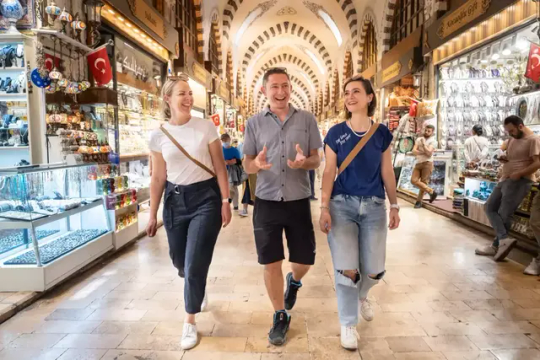
🌍 Your Ultimate Private Istanbul Tour Adventure 🕌✨
Have you ever dreamed of exploring a city that bridges two continents, blending rich history with vibrant modern life? Welcome to Istanbul, where every street has a story, and every view is breathtaking!
🚶♂️ Why Choose a Private Istanbul Tour? A private tour lets you experience the city at your own pace, uncovering hidden gems and skipping the long lines. Whether you're drawn to Byzantine wonders, Ottoman palaces, or bustling bazaars, a personalized tour ensures you see Istanbul your way!
✨ Must-See Istanbul Highlights: 🏰 Hagia Sophia & Blue Mosque – Architectural marvels with centuries of history. 🎭 Grand Bazaar & Spice Market – A sensory delight with endless treasures. 🌊 Bosphorus Cruise – Witness the magical skyline from the water. 🏡 Princes’ Islands & Kadıköy – A peaceful escape from the city's buzz. 💎 Hidden Gems – Explore lesser-known spots like Chora Church & Basilica Cistern.
🗺️ Tour Options for Every Traveler: 📌 One-Day Istanbul Tour – Perfect for first-time visitors! 📌 4-Day Istanbul Adventure – A deep dive into the city's history & culture. 📌 Byzantine Istanbul Tour – Step back in time with a historical journey. 📌 Private Car Tours – Explore Istanbul in comfort & style.
📍 Make Every Moment Count! Let an expert local guide lead the way, sharing fascinating stories and insider tips. From airport transfers to tailor-made itineraries, your journey will be seamless and unforgettable.
📅 Ready to explore Istanbul like never before? Book your private tour today! 🧳✈️
Details: https://bit.ly/3CSqHTN
#Istanbul #Travel #PrivateTour #Bosphorus #Turkey #ExploreIstanbul #LuxuryTravel #HistoryLover #Wanderlust
#Istanbul#Travel#Private Tour#Bosphorus#Turkey#istanbul tour#turkey day#turkey dinner#Explore Istanbul#hippodrome istanbul
0 notes
Text
1.24.25
A pencil, a cup, dead lovers, and imitating intimacy.
As I remember it: I had brought 6 bottles of ginger beer to the party. Hosted by J.M., it was my first Unofficial. I had come alone, and though I knew most everyone there, I remained alone. We were in J.M.'s apartment, which he shared with two roommates. A typical student apartment, complete with CPM furnishings, it had been rearranged to accommodate a folding table for beer pong and the only source of light were several strands of Christmas lights. T.S. was taking candid pictures of everyone with a knock-off Polaroid.
At some point, probably 3 drinks deep, I entered J.M.'s bedroom. He was 2 years older, a senior. He had a nerdy sort of charisma that is quite difficult to come by in our physics world. Still relatively in my shell, I admired him and those in his circle, about which I orbited but never quite made solid contact. His room was small, with a full sized bed against the right hand wall, headboard side nearest to the door, blue plaid bedspread neatly made. Along the left wall was a tall bookshelf, pressed against a black desk, very similar to the one in my apartment (also CPM). Fuzzy in my memory, I scan the knick-knacks scattered around. A framed picture of a woman near some trees, a plush stuffed animal of some kind, books...a cup of pens and pencils.
...
I love the act of snooping. People covet their privacy but so much of the joy and interest I find in life comes from revealing that which we hide. The most interesting people fill their private spaces with objects rich in meaning: a sketchbook with notes from a class that must have had a theme of self reflection; letters hidden under the bed from a longtime friend; a sticky note with passwords; so many photos.
Personal affects that ought to reflect who one is. And the details of a past life I crave to understand. I find it quite easy to overshare because that's when the sharing gets interesting, messy, and meaningful. A dam breaks and suddenly there's a sense of shared freedom. It is connection, or at least I imagine it is.
...
A mechanical pencil branded with the U.S. particle accelerator school logo and website - red grip and eraser holder. A decent amount of lead. I don't at all recall what drew me to it, perhaps just in its mundanity as something J.M. wouldn't notice had gone missing. In my invasions of privacy, I rarely, if ever, took anything. Most often I would leave hints of my presence, typically a doodle or note on a scrap piece of paper; "Halfdan was here" written on the Hagia Sophia.
J.M. appeared as I continued my invasion, though he didn't seem to mind. I said I was going to take something. He pointed to the framed photo on the bookshelf and said, "That's my dead girlfriend."
...
J.M. had been with her for about a year when she drove to the railroad intersection right at the edge of campus. She stood in front of the train and did not get out of the way.
...
Several years later, I would find myself half-heartedly jealous and mostly nostalgic for a past that was not mine upon discovering a set of photos in another romp of snooping. This time, the connection was personal, hence my complicated feelings. Yet just a few years later, that connection would end with another dead girlfriend too.
0 notes
Text
themes and subject
same subject different time frames.
1 image The Virgin & Child (Theotokos) Mosaic, 867 CE, Hagia Sophia, Istanbul, Turkey
2 image follower of Robert Camp in, Virgin & Child before a Fire screen, c 1440, oil with egg on tempera on oak, Netherlands
3 image Simon Vouet, Madonna & Child, 1633, oil on canvas, France
the first image is a mosaic with a gold background that represents divine status "Thus, gold illuminates the universe with the divine light and reveals at the same time the reason common to all things, namely God."(archaeology, 2012). the figures are very flat but firmly and solid showing power and greatness. there halo is also representing light and divinity.
the second image is the virgin and child in this tempera painting it represents the Madonna and Jesus more humanely. There is more sense of depth in the figures and the surrounding background. their flesh is more detailed and has a lot of warm tones. although it is more realistic the facial expression of the Madonna is more stylized. we know that it represents the Madonna other from the title it is the halo that is placed as part of the background resembling a woven chair.
3rd image Madonna and child are represented in a very natural pose looking away from the viewer and the child giving its back to the viewer. it represents the real scenario where a mother is tired and the child is playing. the symbolic gestures of the Madonna and Jesus are still there but shown within the color of their clothes and the plain back ground emphasizing the focus of the eye towards the figure. the painting is a very realistic painting with a polished look.



0 notes
Note
Thanks for explaining about the hijab and the requirement for modesty.
Our former prime minister was very rude about the niqab, referring them to post boxes. There was an understandable backlash against his comments.
I have western values, so my instinct is to support women's empowerment and freedom of choice. But I can see how this clashes with the concept of modesty.
I'm all for finding common ground between western values and Islam.
I worked as a gardener for a spell and I love the Islamic tradition of using water in the garden to create peaceful rippling sounds and movement. I'd love to visit Grenada.
I visited an Ismaili Centre a while back on an architecture tour and it has a lovely garden on the roof with 4 quarters. It's in the middle of a busy city but in the garden, you'd never know.
Further afield, I visited a hilltop village in india called Mandu which has a rich Islamic past. You can hire a bicycle and explore with hardly any tourists because it's so hard to get to from a train station. In another fantasy, I could be your tour guide and show you around. That would be amazing, serving your every need along the way, finding a quiet spot to have a picnic, obeying your requests, tipping the workers/key holders to let us in to see hidden gems.
Actually, the concept of modesty doesn't clash with women's freedom of choice. Because even if it's obligated, it's the woman's choice to get in or not get in hijab. For example, me. I'm not wearing hijab yet.
This doesn't only exist for women, but men as well. We just cover our body to drive less attention, lower the risk of unwanted gaze of people.
A lot of muslims can represent islam very badly, so let me shortly put it like this: Islam is never about women being opressed, never about women being obedient. In marriage, obedience, loyalty and respect is a must for both parts (wife and husband)
Also that seems lovelyyy
There are many islamic architectures in different countries I didn't see yet. But I would like to suggest to see the mosques in Turkey. Hagia Sophia Mosque (it's called Ayasofya here), Eyub Sultan Mosque, Sultan Ahmet Mosque, Grand mosque, Selimiye Mosque and etc.
Hagia Sophia Mosque used to be a cathedral, then it got turned into a mosque. The paintings on the marbles are so beautiful and detailed. Since it used to be a cathedral, there are paintings of biblically accurate angels, Prophet Jesus (yes, Jesus is also a prophet in islam)
There's also an icon of Mother Mary in front of the top window
I prayed there once, the experience wasn't so different than the other mosques but the fact that this mosque used to be a cathedral and is a museum material made this a more interesting experience
#anon asks#send anons#anon ask#anons welcome#asks#send me asks#ask me stuff#send asks#ask#asks are open#benari asks#benari answers
1 note
·
View note
Text
Camlica Tower: Istanbul’s Modern Marvel
İstanbul, a city bridging two continents and a tapestry of rich history, has witnessed countless landmarks rise to prominence. Among its most recent additions is the striking Camlica Tower, a testament to modern engineering and architectural ingenuity. Located on the Asian side of Istanbul, this awe-inspiring structure not only enhances the city’s skyline but also serves as a multifaceted symbol of progress and innovation.
Overview of Camlica Tower
Completed in 2021, Camlica Tower stands at a height of 369 meters (1,210 feet), making it the tallest structure in Turkey. Situated on Camlica Hill, a prominent vantage point offering panoramic views of Istanbul, the tower is visible from both the European and Asian sides of the city. Its primary purpose is to consolidate Istanbul’s numerous broadcasting towers into a single structure, reducing visual pollution and streamlining telecommunication services.
Beyond its functional role, the tower has quickly become a significant tourist attraction, drawing visitors from across the globe. With its sleek, futuristic design and state-of-the-art facilities, Camlica Tower is a prime example of how technology and aesthetics can coexist harmoniously.
Architectural Design
The design of Camlica Tower reflects a blend of modernism and cultural symbolism. Its unique silhouette, inspired by a tulip—a flower deeply ingrained in Turkish heritage—gracefully tapers as it ascends. This design choice not only pays homage to the nation’s cultural roots but also ensures the structure’s stability against strong winds and seismic activity, a crucial consideration in earthquake-prone Istanbul.
The exterior of the tower is clad in a reflective façade that changes appearance depending on the light conditions and time of day, creating a dynamic visual experience. At night, an intricate lighting system illuminates the tower, making it a beacon visible from miles away.
Facilities and Features
Camlica Tower offers a range of facilities designed to provide an unforgettable experience for its visitors. Some of its key features include:
Observation Decks: The tower boasts two observation decks, situated at 148 and 153 meters above ground level. From these heights, visitors can enjoy breathtaking 360-degree views of Istanbul, including iconic landmarks such as the Bosphorus Strait, Hagia Sophia, and Topkapı Palace. The decks are equipped with telescopes and interactive screens that provide detailed information about the sights.
Dining Experiences: Two restaurants and a café within the tower offer exquisite dining options. Visitors can savor Turkish and international cuisine while taking in the mesmerizing views. The rotating restaurant, a standout feature, adds a unique dimension to the dining experience, allowing guests to enjoy a constantly changing panorama.
Broadcasting and Telecommunication Hub: The primary function of Camlica Tower is to house broadcasting and telecommunication equipment. It consolidates over 100 antennas previously scattered across Camlica Hill, significantly improving signal quality and reducing electromagnetic pollution in the area.
Cultural and Event Spaces: The tower includes exhibition areas and event halls that host cultural activities, art exhibitions, and corporate events. These spaces provide a platform for showcasing Turkish art and culture to an international audience.
Sustainability and Environmental Impact
One of the most commendable aspects of Camlica Tower is its commitment to sustainability. The consolidation of multiple antennas into a single structure has dramatically reduced the visual and environmental impact on Camlica Hill. Additionally, the tower’s design incorporates energy-efficient systems, including LED lighting and advanced climate control technologies, minimizing its carbon footprint.
The surrounding landscape has been carefully preserved and enhanced with green spaces, walking paths, and recreational areas, making the site more inviting for visitors and locals alike. This harmonious integration with the natural environment underscores the project’s dedication to ecological balance.
A New Symbol for Istanbul
Camlica Tower has quickly established itself as a symbol of Istanbul’s modern aspirations. Its towering presence represents Turkey’s progress in technology, architecture, and sustainable development. The tower also serves as a reminder of the city’s unique ability to embrace the future while respecting its historical and cultural heritage.
For many, Camlica Tower has become a must-visit destination, offering a contemporary counterpoint to Istanbul’s ancient landmarks. It stands as a beacon of innovation in a city known for its timeless charm.
Visiting Camlica Tower
Visiting Camlica Tower is a seamless experience, with facilities designed to accommodate both local and international tourists. The site is easily accessible by public transport and offers ample parking for those arriving by car. Tickets can be purchased online or at the entrance, with options for guided tours that provide in-depth insights into the tower’s history and features.
Visitors are encouraged to allocate sufficient time to fully explore the tower’s offerings, including its observation decks, dining areas, and cultural exhibitions. The surrounding park area also provides a tranquil setting for relaxation and photography.
Future Prospects
As Istanbul continues to grow and evolve, Camlica Tower is poised to remain a central fixture of the city’s landscape. Plans are underway to further integrate the tower into Istanbul’s tourism network, including collaborations with travel agencies and the development of additional attractions in the vicinity.
Moreover, the tower’s role as a broadcasting hub ensures its ongoing relevance in the telecommunications sector. As technology advances, Camlica Tower will likely incorporate new innovations to enhance its capabilities and services.
Conclusion
Camlica Tower is more than just a structure; it is a symbol of Istanbul’s dynamic spirit and forward-thinking vision. Combining functionality, aesthetics, and sustainability, it encapsulates the essence of a city that continually reinvents itself while honoring its past. Whether as a broadcasting hub, a tourist attraction, or a cultural landmark, Camlica Tower stands tall as a beacon of inspiration and progress in the heart of Istanbul.
0 notes
Text
An Ultimate Guide on Visa to Turkey

Turkey is a land of stunning landscapes, rich history and vibrant culture that blend modern and ancient. This country is located in Southwestern Asia and Southeastern Europe, and served as the crossroads of many civilizations such as Romans, Greeks, Ottomans and Byzantines. Turkey's coastlines along with Mediterranean and Aegean Seas, mountains and historical sites such as the ancient city of Troy, the stunning Hagia Sophia, etc, makes it a famous affordable tourist destination. Before starting on this journey, you need to understand Turkey’s visa policies, extension, documents and application process to ensure a smooth entry into the country.
1. Do you need a visa to go to Turkey?
The main question in our mind: Do we need a visa for Turkey? The answer is Yes, you need an e visa to visit Turkey. Now, Turkey has simplified the process by introducing the Turkey Visa Online system that makes the process easier and quicker for eligible country citizens. This system allows travelers to apply for a Turkey e visa online from your comfort place and eliminate the need to visit any office. Turkey e visa is valid for tourism or trade purposes only, you can enter the turkey at any time within the validity of your e visa but make sure duration of stay and validity period of e visa are different.

2. Which Countries are eligible for Turkey e visa?
Before applying for a visa, you must know which countries are eligible for e visa Turkey. Here is the list of some countries who need a valid e-visa to enter Turkey.
Algeria
Bermuda
Cyprus
Taiwan
Vanuatu
Pakistan
Antigua and Barbuda
Bhutan
Dominican Republic
Suriname
Vietnam
Nepal
Armenia
Burkina Faso
Egypt
Sri Lanka
South Africa
Mauritania
Australia
Cambodia
Equatorial Guinea
Senegal
Solomon Islands
Bahamas
Cameroon
Fiji
Saint Vincent
Philippines
Bangladesh
Cape Verde
Grenada
Mauritius
Mexico
Barbados
China
India
Jamaica
Maldives
3. What are the requirements for e-visa Turkey?
If you are eligible to visit Turkey then understand the Turkey visa requirements that helps to apply for a successful e-visa application. You should need the following documents while applying Turkey e visa:
You must hold a valid passport with the validity of six months.
An active email to receive the e visa once approved.
Mastercard, Credit or Debit Card, VISA card to pay the processing fee.
You have to provide the details of Confirm tickets, Proof of funds, Purpose of travel and Accommodation Information.
4. How to get an e visa for Turkey?
Applying for an e-visa to Turkey is a very simple and straightforward process. It is important to apply for your e visa in advance of your trip to Turkey. Follow the below mentioned steps to fill the application.
Step 1: Fill out the Turkey visa application : You will need to fill the application form with your personal information such as name, email, passport number, travel details, contact number, etc. Double check your information before further proceeding.
Step 2: Pay the eVisa fee : Now, You have to pay the eVisa fee which depends on your nationality. You can use Mastercard, VISA, Credit or Debit card to pay the fee.
Step 3: Submit your application : After paying the processing fee, which is not refundable, submit your application. Your e-visa application will be reviewed.
Step 4: Receive Your e-Visa : Once your e-visa is approved, your visa is sent to your email. Print your e visa and travel to Turkey.
5. Visa Policy and Extension Process
Visa policies are different from the purpose of visit. Foreign travelers who visit Turkey, must fulfill the policies to enter and reside in Turkey. It is designed to maintain security and immigration control in Turkey. eVisa validity for tourism or business purposes is valid up to 90 days, If you want to stay more than 90 days then you have to apply another visa or extend your e visa.
Generally, e visa extension is not always possible but in some cases such as medical, it can be extended. To extend your e visa, you have to visit the Turkey office before expiring the current visa.
6. Can you obtain your e visa on arrival?
VOA or Visa on Arrival is a category of visa issued upon arrival in the country. It is issued for short stay for tourism or business purposes but only a few countries' citizens are eligible for VOA. The period of stay allows for 30 or 90 days within 180 days, depending on the traveler's nationality. VOA entry is the same as e visa entry which is single or multiple. Make sure to obtain your e visa in advance, which is a very fast and convenient process, to avoid wait times.
7. Conclusion
Turkey is a mixture of modern attractions and ancient traditions which makes it an incredible tourist destination. Understanding E visa and its process is the key to a seamless journey to Turkey. E visa allows you to enter Turkey and you can visit any place such as the bustling streets of Istanbul, experiencing the landscapes of Cappadocia, or soaking in the sun along the Aegean coast. So, excited for a trip to Turkey? Pack your bag and apply for an e visa in advance for a beautiful journey to Turkey.
#turkeyevisa#turkeyvisa#turkeyevisaapplication#onlinevisaforturkey#turkeyvisarequirements#turkeyvisaapplicationprocess#turkeyvisaapprovaltime#turkeyevisafees#visaforturkey#turkeytouristvisa#turkeyevisa2025#evisaturkeyapplication#visatoturkey
0 notes
Text
Discover Istanbul with a Private Shore Excursion
Maximize your time in the captivating city of Istanbul with the tailored Istanbul Shore Excursion offered by Istanbul Local Guides. This private tour is specially crafted for cruise ship passengers, providing a seamless blend of history, culture, and personalized exploration.
What to Expect
Your journey begins right at the port, where an expert local guide meets you. A short tram ride brings you to the heart of Istanbul's old city, where you'll dive into its rich history. Key highlights include:

Topkapi Palace: The former residence of Ottoman sultans, now a museum showcasing treasures of the empire.
Hagia Sophia: A 6th-century architectural marvel blending Byzantine brilliance and Ottoman elegance.
The Blue Mosque: Famous for its stunning Iznik tiles, this 17th-century mosque dominates Istanbul's skyline.
The Hippodrome: Once a hub for chariot races, it now features historic landmarks like the Obelisk of Theodosius.
Basilica Cistern: Known as the "Sunken Palace," this subterranean wonder is a striking example of ancient engineering.
Grand Bazaar: Conclude your adventure exploring over 4,000 shops in one of the world’s largest and oldest covered markets.
Why Choose This Tour?
This excursion is perfect for visitors with limited time who want to experience Istanbul Shore Excursion must-see attractions. It offers the convenience of a private guide, flexible itineraries, and insightful narratives, ensuring a memorable day. The tour is also customizable, allowing you to explore your specific interests, from Ottoman history to local gastronomy.
Practical Details
The tour includes guidance by licensed experts and local taxes, but excludes site entrance fees, meals, and personal expenses. Be sure to check the availability of key sites (Topkapi Palace is closed on Tuesdays, and the Grand Bazaar on Sundays).
For more information or to book your personalized Istanbul experience, visit Istanbul Local Guides
0 notes
Text
Top essential items for your trip to turkey
youtube
Turkey is a captivating destination that seamlessly blends history, culture, and natural beauty. Whether you're exploring the bustling streets of Istanbul, soaking up the sun on the beaches of Antalya, or marveling at the ancient ruins of Ephesus, packing the right items can make your trip smoother and more enjoyable. Here’s a comprehensive list of essential items to include in your travel kit for Turkey.
Travel Documents
Ensure you have all your necessary documents ready before traveling:
• Passport and Visa: Turkey requires a valid passport and, for many travelers, a visa. Check online if you’re eligible for an e-visa or need to apply beforehand.
• Travel Insurance: Protect yourself against unexpected situations like medical emergencies or lost luggage.
• Hotel and Flight Details: Keep printed or digital copies of your bookings for easy access.

2. Clothing Essentials
Turkey’s weather varies significantly depending on the season and region:
• Light Layers for Summer: If visiting during warmer months, pack breathable fabrics like cotton or linen for cities like Antalya and Izmir.
• Warm Layers for Winter: For destinations like Cappadocia or Istanbul in winter, bring a heavy coat, scarf, and gloves.
• Modest Clothing: When visiting mosques or conservative areas, pack modest outfits. Women may need a scarf to cover their heads.
• Comfortable Shoes: Whether exploring ancient ruins, cobblestone streets, or hiking in Cappadocia, sturdy walking shoes are a must.

3. Electronics and Gadgets
Keep your devices charged and ready to capture the beauty of Turkey:
• Universal Power Adapter: Turkey uses Type F outlets with a standard voltage of 220V.
• Portable Charger: Ideal for long days of sightseeing or when traveling between cities.
• Camera or Smartphone: The Hagia Sophia, Pamukkale’s travertines, and Cappadocia’s hot air balloons are perfect for Instagram-worthy shots.
Don't miss out! Take advantage of the best deals on flight tickets and hotels to your favorite destinations around the world. Whether you're planning a luxury getaway or a business trip, Trip.com offers a variety of options at unbeatable prices.
• SIM Card or eSIM: Purchase a local SIM card to stay connected or activate an eSIM for data.
Don't miss out! Take advantage of the best deals on flight tickets and hotels to your favorite destinations around the world. Whether you're planning a luxury getaway or a business trip, Trip.com offers a variety of options at unbeatable prices.
Toiletries and Health Essentials
Stay fresh and prepared with these items:
• Sunscreen and Lip Balm: Protect your skin from the Mediterranean sun, especially in coastal areas.
• Hand Sanitizer and Wet Wipes: Essential for hygiene, especially when traveling through crowded areas.
• First Aid Kit: Include basic medications for headaches, upset stomachs, or allergies.

Currency and Money Essentials
Book Your Trip Today with Trip.com – Your Adventure Starts Here! 🌍✈️
Don't miss out! Take advantage of the best deals on flight tickets and hotels to your favorite destinations around the world. Whether you're planning a luxury getaway or a business trip, Trip.com offers a variety of options at unbeatable prices.
• Turkish Lira (TRY): While cards are widely accepted, having cash is useful for local markets and smaller establishments.
• Travel Credit Card: Use a card with no foreign transaction fees for larger purchases.
• Money Belt or RFID Wallet: Keep your money and cards secure, especially in crowded tourist spots.
Travel Comfort Items
Long flights or road trips can be tiring; bring:
• Travel Pillow and Blanket: Perfect for long-haul flights or bus rides.
• Reusable Water Bottle: Stay hydrated while reducing plastic waste.
• Snacks: Keep energy bars or dried fruit handy for when hunger strikes.
Book now and enjoy the best rates on flights and trusted hotels.
Navigation and Guides
Turkey is full of exciting places to explore:
• Maps and Travel Apps: Download apps like Google Maps or Maps.me for offline navigation.
• Guidebook or E-Book: Consider a comprehensive guidebook for insights into Turkey’s history, culture, and attractions.
Must-Haves for Specific Activities
• Swimsuit: Essential for coastal cities like Bodrum or thermal pools in Pamukkale.
• Hiking Gear: For adventurous treks in Cappadocia or the Lycian Way.
• Evening Wear: For fine dining or enjoying Istanbul’s nightlife.
Miscellaneous Items
• Scarf or Shawl: Multipurpose for warmth, modesty, or as an accessory.
• Reusable Tote Bag: Handy for shopping in local bazaars like the Grand Bazaar in Istanbul.
• Notebook or Journal: Document your experiences, sketches, or memories.
A Sense of Adventure
While not a tangible item, an open mind and a sense of adventure are essential for making the most of your Turkish journey. Be ready to immerse yourself in Turkey’s vibrant culture, savor its mouthwatering cuisine, and interact with the friendly locals.
Final Thoughts
Packing smartly for your trip to Turkey ensures you’re prepared for any adventure, from exploring Istanbul’s historical landmarks to enjoying a beach holiday on the Turquoise Coast. With these essential items, you’ll be well-equipped to have a safe and unforgettable journey.
For accommodations, flights, and travel deals, visit Trip.com and plan your trip effortlessly!
0 notes